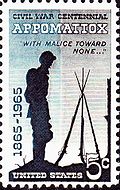- American Civil War Centennial
-
The American Civil War Centennial was the official United States commemoration of the American Civil War, also known as the War Between the States. Commemoration activities began in 1957, four years prior to the 100th anniversary of the commencement of hostilities, and ended in 1965 with the 100th anniversary of the surrender at Appomattox.
Contents
Centennial Commissions
The public commemoration of the Civil War commenced with the passage, by Congress in 1957, of a public act creating the United States Civil War Centennial Commission. The Commission was asked to work with, and encourage, the forty-eight U.S. states (especially the states that were in existence at the time of the Civil War) to create state-level commissions to commemorate the war, and to some extent coordinate centennial activities by the private sector.
The shadow of ongoing conflict over American civil rights affected implementation of these commemorative activities. Neither Congress nor President Dwight D. Eisenhower were interested in a single, unified, national theme for the commemoration. To avoid this, the law creating the federal Commission reflected clear expectations that most of the implementation work of the commemoration would be carried out by the various state commissions. Almost all of the states did indeed set up centennial commissions.
At the same time, the National Park Service, and other federal agencies that controlled key Civil War battlefields, used the Centennial to successfully lobby Congress for increased funding to re-landscape and interpret these battlefields for the general public. The U.S. Post Office issued a series of commemorative stamps to mark the centennial.
Differing themes
The same geographical divisions that had played a role in sparking the Civil War itself also affected the works of the separate state commissions that tried to oversee the Centennial. Not surprisingly, the Northern states' commissions and the Southern states' commissions looked at the war in very different ways, used different key words and phrases to reflect their viewpoints, and sponsored and encouraged different public memorials and activities.[1]
In particular, the governments of U.S. Southern states saw the Civil War centennial as an opportunity to reinforce their view that the infrastructure of Jim Crow and segregation was an organic reflection of a distinctive Southern "way of life." Many white Southerners responded with enthusiasm to invitations to celebrate their heritage, which they saw as one of courage on the battlefield and continuity afterwards. For the first time, many Americans, especially white Southerners, volunteered or were recruited into historical reenactment groups that performed pageants and re-creations of Civil War battles, field maneuvers, and encampments.
The Centennial also saw efforts to use the various commemorations as a launching pad for serious adult education of the facts and issues surrounding the war. Historian Robert J. Cook, in a 2007 full-length study of the commemoration, asserts that these efforts were comprehensively unsuccessful and constituted a significant missed opportunity.[2]
Legacy
One major legacy of the Civil War Centennial was the creation of an infrastructure of Civil War reenactment.[3] In addition, much of the current interpretive infrastructure of the major American Civil War battlefields dates back to planning decisions made in the early 1960s.
Prior to 1957, celebrants of Southern heritage adopted a wide variety of signs and symbols. In the late 1950s, many white Southerners united around a modified version of the battle flag of the Army of Northern Virginia as the flag to be used in commemoration of the Centennial, and this flag was raised at many 100th-anniversary events. For example, the modified Confederate flag was raised on the grounds of the South Carolina State House in April 1961 as part of the 100th anniversary commemoration by South Carolina's government of the reduction of Fort Sumter.[4]
See also
References
- ^ Edward L. Ayers, The Civil War and Emancipation 150 Years On, Southern Spaces 17 May 2011.
- ^ Cook, Robert J. (2007). Troubled Commemoration: the American Civil War centennial, 1961-1965. Baton Rouge, Louisiana: Louisiana State University Press. p. 261[1]. ISBN 978-0-8071-3227-2.
- ^ Hadden, Robert Lee (1999). Reliving the Civil War: a reenactor's handbook. Mechanicsburg, Pa.: Stackpole Books. p. 4.[2]
- ^ ""The Day the Flag Went Up"". scpronet.com. http://www.scpronet.com/point/9909/p04.html. Retrieved 2011-02-05.
Categories:- Modern reenactment
- Historiography of the American Civil War
- Military reenactment
- United States historical anniversaries
- Regional centennial anniversaries
- 1960s in the United States
- American Civil War reenactment
Wikimedia Foundation. 2010.


